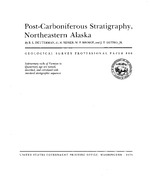Post-Carboniferous stratigraphy, northeastern Alaska
Links
- More information: Publisher Index Page (html)
- Document: Report (4269 pdf)
- Download citation as: RIS | Dublin Core
Abstract
Post-Carboniferous sedimentary rocks exposed in northeastern Alaska constitute an almost continuous sequence representing all systems from Permian to Quaternary. Because the rocks are well exposed, only slightly deformed, and very fossiliferous, they comprise an important biostratigraphic reference section. Regional and local unconformities are present, and minor hiatuses can be identified in the stratigraphic record. The rocks are divided into 3 groups, 14 formations, and 16 members; some are newly named, others revised. The Ignek Formation is abandoned, and the Okpikruak Formation is excluded from the stratigraphic sequence in northeastern Alaska.
The Sadlerochit Formation is raised to group rank and divided into the Echooka (Permian) and Ivishak (Lower Triassic) Formations. The Echooka includes the Joe Creek and Ikiakpaurak Members (both new), and the Ivishak is divided into the Kavik, Ledge Sandstone, and Fire Creek Siltstone Members (all new). The Shublik Formation (Middle and Upper Triassic) is informally divided into siltstone, limestone and dolomite, and clay shale members; it is separated from the Kingak Shale (Jurrassic) by the (Upper Triassic) Karen Creek Sandstone (new). Lower Cretaceous (Neocomian) rocks are mapped as the Kongakut Formation (new). The Kongakut includes the clay shale, Kemik Sandstone, pebble shale, and siltstone members. The Bathtub Graywacke (new) may be in part equivalent to the Fortress Mountain Formation. The Nanushuk and Colville Groups are extended into northeastern Alaska to replace the Ignek Formation. The Nanushuk includes the Tuktu and Chandler Formations, and the Colville is subdivided into its subordinate Seabee, Prince Creek, and Schrader Bluff Formations. All Tertiary rocks are included in the redefined Sagavanirktok Formation, which is divided into the Sagwon, Franklin Bluffs, and Nuwok Members (new). The Gubik Formation (Pleistocene) is extended into northeastern Alaska.
Post-Carboniferous rocks are mainly sandstone, siltstone, shale, and conglomerate, and include both marine and terrestrial deposits with a cumulative thickness of about 8,500 m (28,000 ft). Marine transgressions and regressions are identified in the stratigraphic sequence, and a major shift from a northern source area for the older rocks to a southern source for the younger rocks is demonstrated. This change took place during the Early Cretaceous, and the Bathtub Graywacke is the first unit to clearly reflect a southerly source area. Post-Carboniferous orogeny in northeastern Alaska started during the Aptian Stage of the Lower Cretaceous. Pre-Aptian sandstones are mature, clean, quartz arenites, whereas most post-Aptian sandstones are lithic arenites or graywackes.
Study Area
| Publication type | Report |
|---|---|
| Publication Subtype | USGS Numbered Series |
| Title | Post-Carboniferous stratigraphy, northeastern Alaska |
| Series title | Professional Paper |
| Series number | 886 |
| DOI | 10.3133/pp886 |
| Year Published | 1975 |
| Language | English |
| Publisher | U.S. Government Printing Office |
| Description | iii, 46 p. |
| Country | United States |
| State | Alaska |


